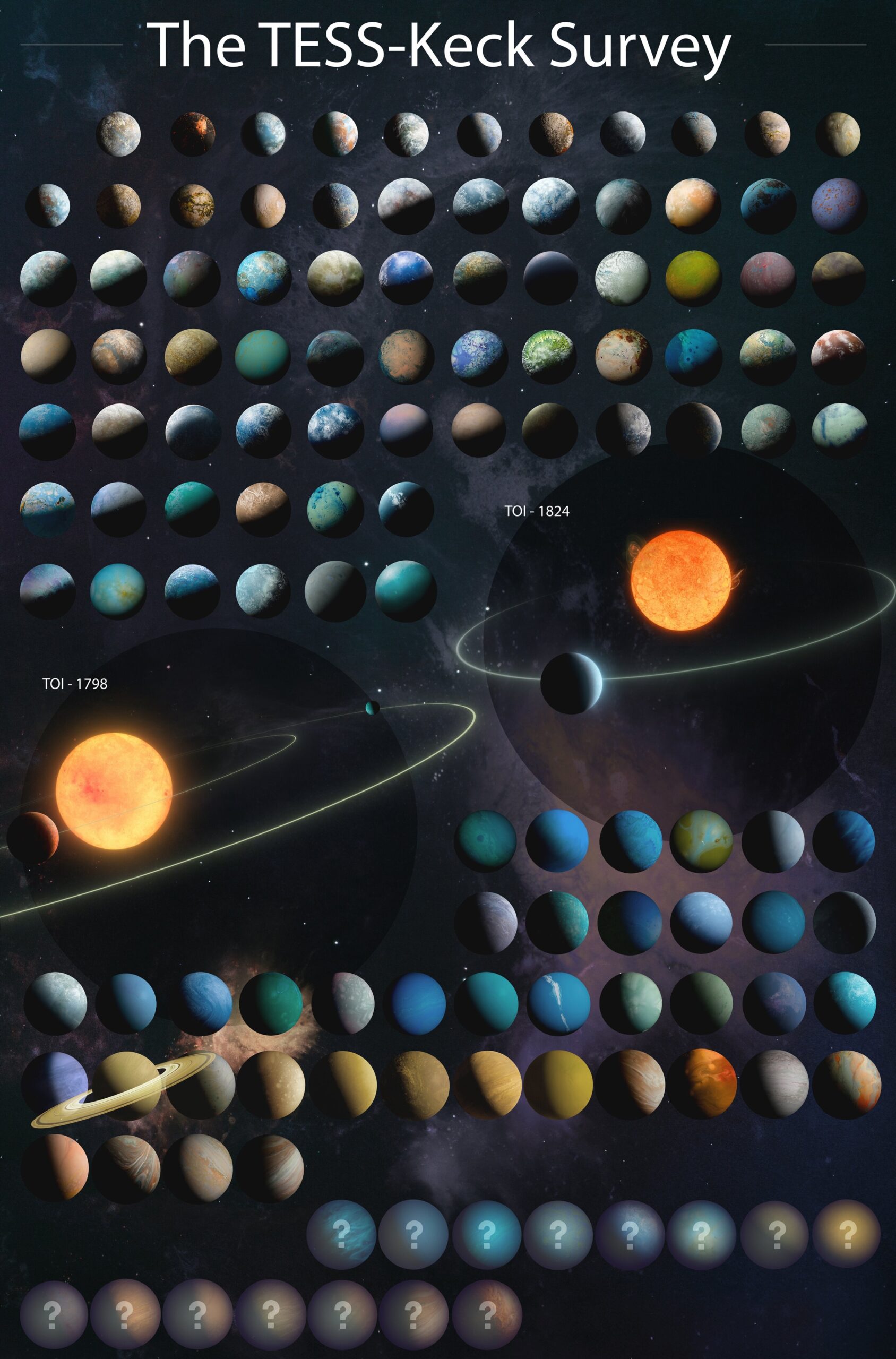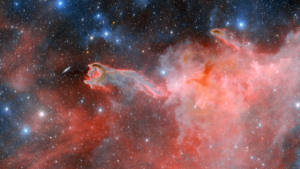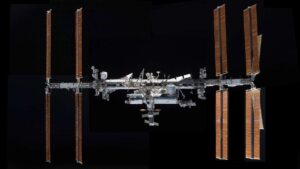An artist’s concept of the 126 planets in the latest TESS-Keck Survey catalog is based on data including planet radius, mass, density and temperature. Question marks represent planets requiring more data for full characterization. Courtesy: WM Keck Observatory/Adam Makarenko
× near
An artist’s concept of the 126 planets in the latest TESS-Keck Survey catalog is based on data including planet radius, mass, density and temperature. Question marks represent planets requiring more data for full characterization. Courtesy: WM Keck Observatory/Adam Makarenko
While thousands of planets have been discovered around other stars, relatively little is known about them. NASA’s catalog of 126 exotic, newly discovered worlds includes detailed measurements that allow comparisons with our own solar system.
The catalog describes a fascinating mix of planet types outside our solar system, from rare worlds with extreme environments to ones that could possibly support life.
The planets were analyzed by a large international team of scientists using NASA’s Transiting Exoplanet Survey Satellite (TESS) in collaboration with the WM Keck Observatory on Maunakea, Hawaii. They are described in today’s edition of The Astrophysical Journal Supplement Series.
“Relatively few of the exoplanets known so far have measurements of both mass and radius. The combination of these measurements tells us what the planets might be made of and how they formed,” said Stephen Kane, an astrophysicist at UC Riverside and principal investigator of the TESS-Keck survey.
“With this information, we can begin to answer questions about where our solar system fits into the grand tapestry of other planetary systems,” Kane said.
The research team spent three years developing the catalog. They analyzed more than 13,000 radial velocity (RV) measurements to calculate the masses of 120 confirmed planets, plus six candidate planets located in the northern sky.
Although the planets themselves are not visible, they have a visible effect. As they orbit, the planets pull on their host stars, causing them to “wobble.” As the star moves toward a telescope, its visible light becomes slightly bluer; as it moves away from us, the light becomes slightly redder.
This is very similar to the behavior of sound. Because of the Doppler effect, the fire engine’s siren gets louder as it approaches and lowers as it moves away.
“These RV measurements allow astronomers to discover and learn the properties of these exoplanetary systems. “When we see a star wobble regularly, we can infer the presence of an orbiting planet and measure the planet’s mass,” said Ian Crossfield, a University of Kansas astrophysicist and catalog co-author.
Several planets in the TESS-Keck survey stand out as touchstones for deepening astronomers’ understanding of the different ways planets form and evolve.
A related survey published in The Astronomical Journal and author UCR graduate student Michelle Hill announces the discovery of two new planets orbiting a star like our sun. The first is a “sub-Saturn” planet with a mass and radius between those of Neptune and Saturn.
“There’s an ongoing debate about whether sub-Saturn planets are really rare, or whether we’re just bad at finding planets like these,” Hill said. “So this planet, TOI-1386 b, is an important addition to this demographic of planets.”
TOI-1386 b takes only 26 days to orbit its star. Meanwhile, its neighbor, a planet with a mass close to that of Saturn, takes 227 days to orbit the same star.
Another poll written by UCR graduate student Daria Pidgorodetska and available at arXiv preprint server, describes a planet about half the size of Neptune that takes only 19 days to orbit its star, which is very similar to our sun.
“Planets smaller than Neptune but larger than Earth are the most common worlds in our galaxy, but they are absent from our own solar system. Every time a new one is discovered, we are reminded of how diverse our universe is, and that the space we exist in may be more unique than we can understand,” Pidgorodetska said.
There are many stars that are not like our sun. If scientists want to make proper comparisons between our world and others, they need to find stars of similar age, size, and mass. “Then we can make apples-to-apples comparisons,” Kane said. “That’s the exciting part of the documents produced by Michelle and Daria, because they allow that.”
Planets with even more extreme, ultra-short orbits around stars unlike our sun are also detailed in the catalog. One is so close to its orange dwarf star that it completes its orbit in less than 12 hours.
TOI-1798, a system that is home to two planets. The inner planet is a strange Super-Earth so close to its star that a year on this alien world lasts only half an Earth day. Courtesy: WM Keck Observatory/Adam Makarenko
× near
TOI-1798, a system that is home to two planets. The inner planet is a strange Super-Earth so close to its star that a year on this alien world lasts only half an Earth day. Courtesy: WM Keck Observatory/Adam Makarenko
“TOI-1798 c orbits its star so fast that a year on this planet lasts less than half a day on Earth. Because of their proximity to their host stars, planets like this are also ultra-hot — receiving more than 3,000 times the radiation that Earth receives from the sun,” said Alex Polanski, a graduate student in physics and astronomy at the University of Kansas and lead author of the catalog paper.
“Existing in this extreme environment means that this planet has probably lost any atmosphere it originally formed,” Polanski said.
Ultimately, this new catalog represents a major contribution both to NASA’s TESS mission and to answering the question of whether other planets are capable of hosting life as we know it.
“Are we unusual? The jury is still out on that question, but our new mass catalog represents an important step toward answering that question,” Kane said.
More info:
Polanski and others. The TESS-Keck study. XX. 15 new TESS planets and a single RV analysis of all survey targets The Astrophysical Journal Supplement Series(2024). DOI: 10.3847/1538-4365/ad4484, iopscience.iop.org/article/10. … 847/1538-4365/ad4484
Michelle L. Hill et al., The TESS–Keck Study. XIX. A warm sub-Saturn-mass transiting planet and a Saturn-mass non-transiting planet orbiting a solar counterpart, The Astronomical Journal (2024). DOI: 10.3847/1538-3881/ad2765
Daria Pidgorodetska et al., The TESS-Keck Study. XXII. TOI-1437 in orbit below Neptune, arXiv (2024). DOI: 10.48550/arxiv.2405.12448
Log information:
arXiv
Astronomical Journal



